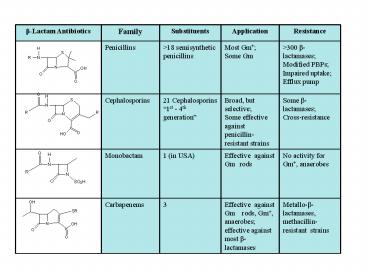Cipro Ciprofloxacin - PowerPoint PPT Presentation
1 / 18
Title:
Cipro Ciprofloxacin
Description:
Effective against Gm ? rods, Gm , anaerobes; effective against most -lactamases ... Disease caused by Bacillus anthracis, a gram-positive spore-forming bacteria ... – PowerPoint PPT presentation
Number of Views:4838
Avg rating:5.0/5.0
Title: Cipro Ciprofloxacin
1
2
3
Cipro (Ciprofloxacin)
- Cipro
- Antibiotic effective treatment against Anthrax
bacteria - Also used in the treatment of UTIs and
Pyelonephritis - Kidney infection caused by food borne illness E.
coli - Treats bacterial infections from bronchitis to
gonorrhea - Antimicrobial HIV/AIDS medication
4
Structure of Cipro
- Cipro XR
- Quinolone
5
Drug Classification
- Quinolones antimicrobial agent
- Most have excellent bioavailability
- Adverse effects nausea, headache, dizziness, and
confusion - Rapidly inhibit DNA synthesis by promoting
bacterial DNA cleavage in the enzyme components
of DNA gyrase and type IV topoisomerase,
resulting in rapid bacterial death - Exhibits concentration-dependant bacterial
killing - Well absorbed following oral administration
- Drug administered every 12 to 24 hrs elimination
half-lives range from 1.5 to 16 hrs.
6
Mechanism of Action
- Inhibits bacterial nuclear DNA synthesis
- Rapid death of bacteria
- Target sight for Cipro is the enzyme DNA gyrase
(topoisomerase II) - Responsible for the supercoiling and uncoiling of
the DNA - Supercoiling allows long DNA to fit into a cell
- Uncoiling required for replication,
transcription, and DNA repair - Cipro prevents bacterial DNA from creating
enzymes and reproducing
7
Side Effects
- Gastrointestinal intolerance
- Nausea, vomiting, diarrhea
- Photosensitivity
- Occasionally CNS toxicity
- Dizziness and tremors
8
Pharmacokinetics/Chemistry
- Absorbed from the gastrointestinal tract after
oral administration - The unrestricted bioavailability is 70 with no
significant loss by first pass metabolism - Elimination half-life is approximately 4 hrs
- Urinary excretion of Cipro complete in 24hrs
9
FDA approval
- Approved on July 28th, 2000
- Approved for post-exposure to inhalation anthrax
- Approved under accelerated approval regulations
10
Ciprofloxacin Antibiotic for the Treatment of
Anthrax
11
Anthrax as a Biological Weapon
- LD one millionth of a gram
- LD50 2,500 to 55,000 inhaled anthrax spores
- If 100 kg of anthrax spores were released into
Washington, DC, an estimated 130,000 to 3 million
would die.
12
How is anthrax spread?
- Inhalation - spores can be inhaled in
contaminated soil. - cutaneous (skin) - spread by biting insects that
have fed on infected hosts (95 of anthrax cases) - gastrointestinal caused by ingesting
undercooked meat or unchlorinated water that
harbors anthrax bacteria
13
Symptoms of Anthrax
- Inhalation occurs in two stages that surface in
approximately 7-10 days - Stage 1 - begins with fever, cough, headache,
vomiting, chills, weakness, abdominal pain,
shortness of breath and chest pain.
(hours-several days) - Stage 2 - fever, difficulty breathing, sweating,
a bluish discoloration of the skin, shock, and
finally death (2-4days) - Cutaneous occurs within 12 days of exposure
- localized swelling of the skin, which enlarges
into an ulcer and discharges a clear fluid. Then,
a black scab will form that falls off in one to
two weeks. - Gastrointestinal occurs within several days
- symptoms include nausea, vomiting blood,
abdominal pain, bloody diarrhea, and weakness - Results in death for 25 to 60 percent of cases
14
Anthrax Life Cycle
http//www.ph.ucla.edu/epi/bioter/anthraxlifecycle
.html
15
Anthrax
- Disease caused by Bacillus anthracis, a
gram-positive spore-forming bacteria - anthrax spores are found in the soil
- Spores have no smell, taste, or color and are too
small to be seen by eye - need an environment that is rich in amino acids,
nucleosides and glucose to germinate - Once the germination begins, the disease
progresses very rapidly - Not contagious
16
Anthrax in a host
- bacteria attacks the lymph nodes
- three proteins are created by the bacteria
protective antigen (PA) - edema factor (EF)
- lethal factor (LF)
- the lethal factor cuts mitogen-activated protein
kinase, an enzyme that controls cell growth and
is involved in cellular signal transmission - disrupting signal transmission results in anthrax
symptoms
17
Fatality Statistics of Anthrax
- Cutaneous 20
- Inhalation 75
- Gastrointestinal - 25-60
- Statistics according to the Center for Disease
Control (CDC)
18
Diagnosis and Treatment
- Diagnosis through Gram-staining
- A blood sample is cultured and then gram-stained
to identify the genus level (Bacillus family) - Cutaneous - vesicular fluid and bloodInhalation
- blood, cerebrospinal fluid, or chest
X-rayGastrointestinal - blood - Treatment
- Anthrax can be treated with the antibiotics,
penicillin, doxycylcine, or ciprofloxacin. - If inhalation anthrax is not caught soon, then
the bacteria can be destroyed but the toxins
remaining in the system will kill the host.
Gram-stained anthrax

